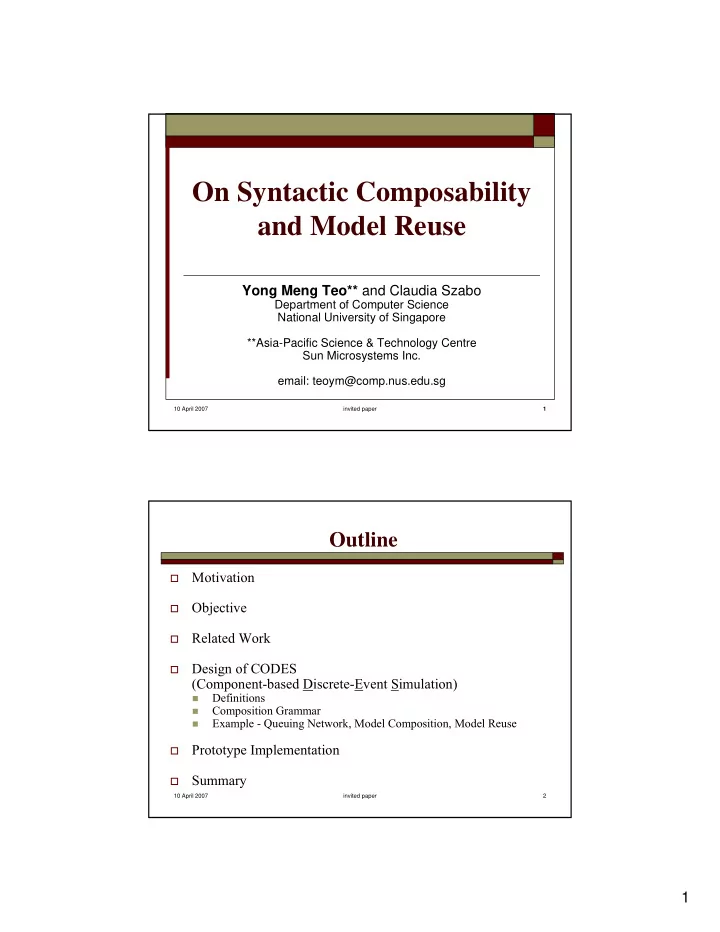

On Syntactic Composability and Model Reuse Yong Meng Teo** and Claudia Szabo Department of Computer Science National University of Singapore **Asia-Pacific Science & Technology Centre Sun Microsystems Inc. email: teoym@comp.nus.edu.sg 10 April 2007 invited paper 1 Outline Motivation � Objective � Related Work � Design of CODES � (Component-based Discrete-Event Simulation) Definitions � Composition Grammar � Example - Queuing Network, Model Composition, Model Reuse � Prototype Implementation � Summary � 10 April 2007 invited paper 2 1
Motivation � Development of Modeling and Simulation program-centric � model-centric � model sharing � 1-1 � 1-many � many-to-many � simulation models reuse to reduce simulation development � time and cost …. � � Simulation Environment increasing trend to use Internet-based infrastructure for � more pervasive sharing of resources – grid, p2p, web services, service-oriented architecture, etc. advance simulation models and knowledge sharing on a � larger and wider scale quantum leap in capability and the size of the simulation � applications 10 April 2007 invited paper 3 Objective To design and develop methodology, abstraction and techniques to facilitate service- oriented simulation model sharing through composable models . this talk Syntactic Composability Semantic Composability Acknowledgement – M. Petty et al. 10 April 2007 invited paper 4 2
Some Issues Model discovery � NP complete problem � Dependant on component representation � Expose components as services? (Service Oriented � Modeling and Simulation) Syntactic validity – component interoperability � Semantic validity – is the composition semantically � meaningful? Reuse � Model (Component) representation? Attributes, functionality, � constraints, …. 10 April 2007 invited paper 5 Related Work Approaches Syntax Semantic Reuse Discovery Examples COST (02) Black Box √ JSIM (99) DEVS (Discrete DEVSJava Event System √ (00) Specification) BOM (Base Object BOMWorks √ √ ? √ Model) (04?) Fractal Component OSA (06) √ √ √ Model 10 April 2007 invited paper 6 3
Component-based Modeling and Simulation Syntax Syntax Semantics Semantics rules rules rules rules Model repository Model repository Semantics Semantics Semantics Semantics Syntax Syntax Syntax Syntax Locator Locator Validator Validator Component interaction Component interaction Time management Time management Data management Data management Model Composer Model Composer Model Composer Model Composer Actuator Actuator Actuator Actuator Distributor Distributor CODES CODES Framework Framework Conceptual Conceptual Conceptual Conceptual Simulation output Simulation output Simulation output Simulation output Model Model Statistics Statistics Statistics Statistics Model Model CODES CODES GUI GUI 10 April 2007 invited paper 7 Design of CODES (Component-based Discrete-Event Simulation) layered approach to facilitate model discovery - syntactic then � semantic A CODES simulator consists of components linked by � connectors . A component is a black-box with an input communication � channel (‘in’) and an output communication channel (‘out’). name type in out attributes …. A connector links two or more components and is one of � three types: one-to-one, one-to-many (fork) and many-to-one (merge). 10 April 2007 invited paper 8 4
Design of CODES (2) Hierarchical component architecture to support model � composition and reuse within and across application domains 10 April 2007 invited paper 9 Design of CODES (3) Extendable syntactic composition rules � composition � grammar defines composition and reuse rules CODES EBNF Composition Grammar – divided into 2 parts � (a) Base Composition Rules extend by adding rules for new application domains 10 April 2007 invited paper 10 5
Design of CODES (4) (b) Application specific composition rules 10 April 2007 invited paper 11 Queuing Networks – Components & Connectors 10 April 2007 invited paper 12 6
Example of Model Composition A Computational Grid with Two Virtual Organizations Number of Components: 11 Production String: Grid_QN = Source ConO Server ConF (Server ConF (Server ConJ Sink) (Server ConJ Sink) (Server ConJ Sink)) (Server ConF (Server ConJ Sink)(Server ConJ Sink)) 10 April 2007 invited paper 13 Example of Model Reuse Assume VOs are models found in the model repository � Virtual Organization 1: VQ1_QN = Server ConF (Server ConJ)(Server ConJ) (Server ConJ) Virtual Organization 2: VQ2_QN = Server ConF (Server ConJ)(Server ConJ ) Reusing model components � Number of Components: 6 Grid_QN = Source ConO Server ConF (Rep_Comp Sink) (Rep_Comp Sink) 10 April 2007 invited paper 14 7
Prototype Implementation Purpose – experimental test-bed for syntactic composability � Base components implemented using SSF (Scalable � Simulation Framework) Java API CODES GUI � Simulation Modeling � Graphical input of simulation model � Syntactic composition checks � Simulation Execution � Automatic code generation – Java-based simulator � using SSF Demo � 10 April 2007 invited paper 15 Summary focus on syntactic composability � use of EBNF and hierarchical component definitions to � describe/represent syntactic composability support component (model) discovery and reuse across � application domains extendable to support new application domains � further work � composability index to quantify degree of syntactic match � of models - facilitate model discovery and reuse Semantic composability � My webpage: www.comp.nus.edu.sg/~teoym 10 April 2007 invited paper 16 8
Recommend
More recommend